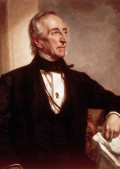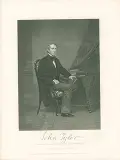President John Tyler
John Tyler was a lawyer and politician who became the first Vice-president to succeed to the presidency. Tyler was born on March 29, 1790, one of eight children of Mary and John Tyler. His father was a judge and later governor of Virginia; his mother was a plantation heiress. She died when young John was 7. 
John grew up at Greenway Plantation and followed in the family footsteps to study at William and Mary College. He was an excellent economics students, earned a law degree when he was 19, and became a judge. He furthered his law knowledge by studying privately with his father and with Edmund Randolph, America's first Attorney General. Tyler was elected to the Virginia General Assembly and served several years on the Courts and Justice committee. He followed in his father's footsteps in opposing nationalist proposals. (His father had not supported ratification of the Constitution because he thought it gave the federal government too much power.) Tyler was a proponent of war with Great Britain and saw his wish realized in 1812. During the war, he organized a militia; because the small fighting force no action, he dissolved it after a few months. The people of Virginia elected Tyler to the House of Representatives in 1816. He served two consecutive terms in the House and made known his opposition to nationalist legislation such as that for the Bank of the United States and the Missouri Compromise. He was personally opposed to the spread of slavery, but he didn't think that the Missouri Compromise was the answer. Dismayed at the passage of the Compromise and suffering from physical illness, Tyler did not seek re-election in 1820, preferring to go back to his law practice. He found himself wanting to join the political scene in 1825 and ran for governor of Virginia. He won and then won re-election. (The term was one year then.) He resigned in 1827 to run for Congress and won a seat in the Senate, where he served until 1836. 
Tyler, originally a member of the Democratic-Republican Party, had initially joined the new Democratic Party but refused to support President Andrew Jackson after his handling of the Nullification Crisis. Instead, Tyler joined the new Whig Party. Tyler's staunch support of states' rights (even at the expense of the power of the national government) made him unpopular of the leader of the Whig Party, Henry Clay, but the Whig Party wanted to defeat Martin van Buren in 1840 and so nominated Tyler to run alongside William Henry Harrison in the Election of 1840. When they won, Tyler became Vice-president of the United States. This election campaign was not Tyler's first as a vice-presidential candidate. Four years earlier, in the Election of 1836, the Whig Party had nominated four candidates in order to counteract the popularity of the Democratic candidate, incumbent Vice-president Martin van Buren. Tyler had been nominated for Vice-president alongside presidential candidate Hugh L White. White won only two states; in fact, the Whig strategy backfired and van Buren was elected easily. 
Harrison and Tyler were inaugurated on March 4, 1841. Harrison gave the longest inaugural address in history, in bad weather, without a hat and coat, and caught a cold. He died a month later, and Tyler quickly had himself sworn in as President. The Constitution had no specific procedures for doing this, but Tyler found no immediate objections to his actions and so set a precedent. (At the time, he was the youngest President, at 51.) He did encounter objections later on. He refused to sign bills advocating a national bank or other nationalist measures. One by one, Tyler's Cabinet members resigned. Only Secretary of State Daniel Webster stood by Tyler. Tyler soon found himself the target of not only the Democratic Party but also his own Whig Party, the leaders of which disowned him and expelled him from the party, hanging on him the dubious nickname "His Accidency." When he vetoed a tariff bill, the House introduced a resolution of impeachment; it failed. He was also the first President to have a veto overridden by Congress. Webster resigned as well, and Tyler eventually appointed an entire new Cabinet. He launched a brief run for re-election, having to start a new political party to do so, but he was sure of very little support and so stopped running. He served out his term as President and did not run for re-election, throwing his support behind the Democratic candidate, James K. Polk, who won the election. He did have some successes as President:
Tyler left political life and served for a time as Chancellor of the College of William and Mary. However, the advent of the Civil War gave him two opportunities to rejoin the political fray. He was the chairman of the 1861 Peace Convention, a failed attempt to prevent war. After Virginia seceded from the Union and joined the Confederacy, Tyler won election in the Confederate Congress. Later in his life, Tyler struggled more and more with recurrences of illnesses that he had suffered through earlier. He died of a stroke on Jan. 18, 1862, before attending the first session of the Confederate Congress. He was buried at Hollywood Cemetery in Richmond. Because of Tyler's preference for and service with the Confederacy, the U.S. Government did not officially recognize his death for many years. Other notes:

|
|
Social Studies for Kids
copyright 2002–2024
David White




